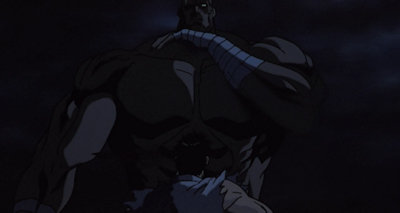
The Japanese and English versions have different soundtracks. The Japanese music is more subdued and optimistic; the English music is darker and more heavy handed. I like both but prefer the English version overall.
Review by Jay Wilson There’s a scene in Street Fighter II: The Animated Movie where we follow a tertiary character, Balrog, to Las Vegas for a meeting with people we’ve never met and will never see again, discussing a deal that has no meaningful connection to the plot. The scene then strays even further to show an attraction at that particular casino. In another movie, I would complain that this is a complete waste of time with zero relevance to anything. However, in this movie, that attraction happens to be a battle between the wild beast, Blanka and the Red Cyclone, Zangief. In truth, the aforementioned business meeting was just a thinly veiled excuse to work in this one fight sequence, and you know what? I’m not complaining. This movie is called Street Fighter, those are Street Fighter characters, and this is a fight between them. This is exactly what I came here for. And do you want to hear something else? The movie as a whole doesn’t really work. Many plot points are clunky, the resolution makes no sense, characters just up and disappear, and maybe that holds it back from being a wall to wall masterpiece, but so what? If you’re going to fail at something, fail at the part people expect to be there, but don’t really care much about. What matters is when the world warriors and new challengers raise their fists, Street Fighter II: The Animated Movie is nothing short of amazing. 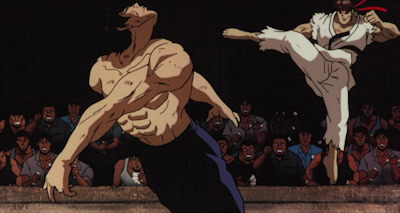
Ryu’s hurricane kick struck Fei Long in the head, sending him flying and twisting through the air. Notice how his torso and arms follow in the momentum as he spins.
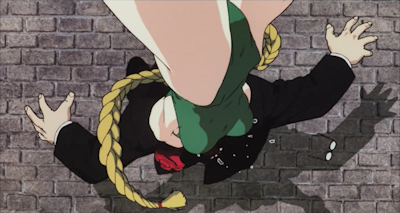
The animators were anything but timid about foreshortening. Not only is the camera angle creative, but Cammy is dynamically twisting into frame as she snaps a politician’s neck.
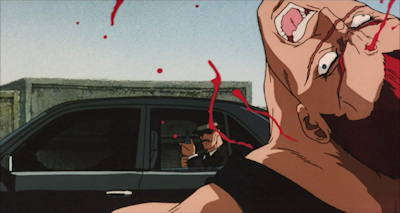
Before unrated home releases became mainstream, the MPAA would often cripple movies with its inconsistent rating policy, especially after a national tragedy. It’s one of the reasons the 1994 live action Street Fighter has no teeth ... not that it had any teeth to begin with.
I love the attention to detail given to the fights. Animation will often show a character throw a punch or kick by having said character extend an arm or a leg, but not this anime. This anime will go out of its way to show Ken’s full-body windup to deliver a roundhouse kick with enough momentum that you feel the impact as he smashes Ryu face first into a cliff. And it’s not just the characters’ movement either. Guile gets fed up trying to hit a teleporting M. Bison and turns around, the camera zooms out from a mid-shot to show him summoning energy, then dynamically zooms back in to his hands as he releases the sonic boom. Director Gisaburo Sugii and his animators knew that with sixteen characters and at least one fight per character, they would need to do something so the action would never get repetitive, so they went all in on making each and every engagement as creative and breathtaking as possible. And paradoxically enough, this is where sixteen (mostly) unique characters proves a boon instead of its usual hindrance. Fighting games typically feature large casts of diverse characters with radically different signature moves so every player can find a style they like. This in turn translates into each battle having its own unique flavor. I often compare Cammy’s low roundhouse to something a gymnast on a pommel horse would do, and while that specific move does not appear in the anime, the spirit of it is captured when Cammy performs a handstand on a guy’s shoulders before twisting his head around, snapping his neck, and dismounting like a psychotic Olympian. By contrast, Zangief drives Blanka skull-first into the concrete with his trademark spinning piledriver, channeling his game counterpart more directly than Cammy. But the greater point is the brainwashed British operative attacks with fluidity and grace while the Russian grappler attacks with blunt force trauma. Plus with Blanka in the mix, it nicely demonstrates the varying levels of fantasy and mysticism: some fights are more acrobatic/martial arts focused that are hypothetically possible while other fights feature a green monster generating electricity through his skin. Likewise, the overall tone of each and every fight is different. Comic relief finds its way into E. Honda and Dhalsim’s bout as the Indian yoga master hovers in the air, avoiding the Japanese sumo’s overcommitted sweep, resulting in Honda spinning around and around like, well, like a cartoon character. Then on the opposite end of the spectrum, Vega stalks Chun-li like something out of a horror movie which leads into the most bone-crunchingly brutal fight of the entire movie, a visceral back-and-forth where claws draw blood, faces get stomped, furniture gets thrown, and one mutilated character gets kicked head-first through a wall. And the variety continues: Dee Jay takes out a couple of nameless street thugs in the blink of an eye; meanwhile M. Bison has a marathon battle against world warriors Guile, Ryu, and then Ryu and Ken together. One fight takes place in a back alley, a couple on the street, one on a mountain top, a couple more in various arenas, and one even takes place on the wing of an aircraft. Again, the artists went out of their way to make each fight a unique experience. 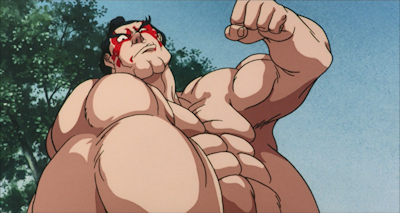
In closeups, E. Honda is ripped which is physically impossible because fat covers muscle and sumo wrestlers are fat.
That’s not a complaint—I understand why they did it—I just find it funny.

M. Bison uses cyborgs to track down Ryu and Ken and other notable street fighters. I love how this one tries to nonchalantly walk away after Chun-li casually points it out.
But that’s not to say Street Fighter II: The Animated Movie is an uninterrupted parade of fights. It actually strikes a nice balance of developing its story and characters because it’s smart enough to prioritize them: the central conflict revolves around M. Bison’s scheme to brainwash Ryu and Ken and turn them into super soldiers, giving investigators Chun-li and Guile secondary roles to advance the plot, relegating everyone else to cameos. This gives the major battles context and it also buys itself the leniency to indulge in the occasional detour to squeeze in characters who otherwise wouldn’t get any screen time, the clunkiest example being T. Hawk, the Native American goliath, who challenges reigning U.S. martial arts champion, Ken, to a battle for honor by jumping him in a shady back alley. It’s also smart enough not to rewrite characters for absolutely no reason, which allows Street Fighter II: The Animated Movie to get away with skimping on introductions for non-priority characters because it can lean on the arcade for support. Without saying a word, Balrog walks down a long corridor with Bison, Vega, and Sagat, and just his proximity to the other SF2 bosses informs the audience, “Yes, your game knowledge applies here: Balrog is a mean son of a bitch whose desire to hurt people is surpassed only by his greed, and he currently works for Shadoloo as one of M. Bison’s henchman, that is until a higher bid comes along, and, oh yes, you’re probably not going to see him use any kicks.” It’s free character development that doesn’t take any time, which is good because Balrog might be on screen for a grand total of five minutes, and most of that is standing in the background. He doesn’t do much, but Balrog is still Balrog, unlike the live action Balrog who is a cameraman for absolutely no reason. On that note, adaptions to accommodate the new medium are fine. Cammy, for example, is brainwashed in the animated movie and programmed to perform an assassination which is semi-true to the game, not to mention entirely dependent on exactly which game you play. In her Super Street Fighter II: The New Challengers ending, we learn Cammy suffers from amnesia, and the exact reason behind said amnesia is unknown other than Bison somehow being involved. When she confronts the Shadoloo dictator, he claims they were in love and she had a horrible accident, which makes her question who she used to be and who she currently is, but then her comrades assure her he must be lying because, “Nobody could love a monster like that.” None of that is mentioned in the anime, but that’s okay because brainwashing explains amnesia, so Cammy is still Cammy. Filling in a question mark with a plausible explanation is fair game. The time frame is still off, but that’s splitting hairs, especially since it effectively sets up the anime’s central theme of mind control. 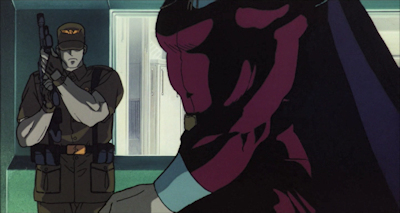
In addition to making characters bigger than life, animation can also feature the game’s colorful costumes without looking out of place.
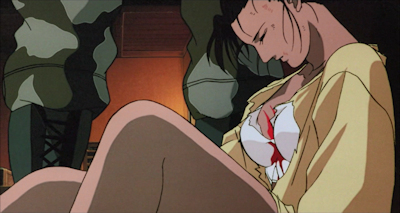
A lot of action movies with a female protagonist shy away from having anything bad happen to her or introduce a female antagonist for them to fight out of fear of being labelled mysogynistic.
I love that Chun-li goes up against Vega and that it’s a vicious fight for both combatants. It makes Chun-li that much more badass. 
This is my favorite shot in the movie. Guile uppercuts as Bison teleports away. The dictator’s boot slides into frame, revealing his new location, and a moment later his cape flows into view, concealing the overwhelmed and soon-to-be defeated protagonist.
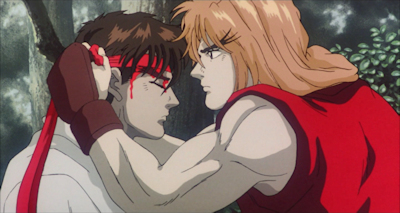
This is the kind of character development appropriate for an action movie: a simple little gesture that shows the friendship of these two rivals and explains the origin of Ryu’s iconic headband.
I was also impressed with the use of flashbacks, for once. Most of the time amateur writers call upon the flashback to inject sophistication without realizing it comes at the expense of pacing; and mishandled, a flashback stops the current storyline to fill in miscellaneous trivia. In Street Fighter II: The Animated Movie, however, M. Bison kidnaps and brainwashes Ken, turning him into a mindless minion. Ken’s memories are what bring him back, making the flashbacks not just relevant but the actual resolution to the main conflict. Furthermore, most of the flashbacks are threaded into the narrative when Ken’s rival, Ryu, is training—when he’s most likely to think about his lifetime friend and sparring partner. Not all of them; I didn’t say it was handled perfectly. The flashbacks with Ken are still pretty clunky: reminiscing while driving and nearly getting himself and his fiancée killed, but at least the information has a purpose and a payoff. As mentioned in the second paragraph, though, Street Fighter II: The Animated Movie has an odd habit of building up an idea and then abandoning it. The opening scene features the final battle of the Street Fighter 1 arcade game where Sagat, the Emperor of Muay Thai, famously received his scar from Ryu’s shoryuken. Street Fighter II, both the game and the anime, brings Sagat back as M. Bison’s right hand man, but he’s not given anything to do. In the third act, Bison sends Sagat on a mission to kill Cammy and Vega, both of whose arcs were satisfactorily resolved—Cammy was discarded by Bison, himself, because she completed her objective and no one would ever be able to crack his mind control, and Chun-li gave Vega a dramatic sendoff at the end of their epic battle. Both characters could return for a sequel, of course, but as far as their purpose in this movie, they were done. Sagat’s third act mission, however, opens both tangents back up and leaves them open because the Emperor of Muay Thai is never seen again. He doesn’t even get mentioned again. Not even his mission gets any kind of acknowledgement which is particularly peculiar because, success or failure, you would think Guile or Chun-li would have something to say about it, seeing as how Cammy is in their custody. But what bothers me the most is that they made Bison childishly overpowered. He reflects Ken’s hadouken, teleports every time Guile swings at him, and blasts Ryu across the countryside again and again—all without blinking. Nobody can touch him. Now generally, the more formidable the villain, the greater the hero that defeats him, but it’s taken to such extreme that the heroes do not defeat him. Bison defeats himself when he arbitrarily decides to turn off God mode to “fight them on their own level.” The battle that ensues where Bison is actually throwing punches and not hiding behind his psycho power is pretty sweet, don’t get me wrong, but the whole thing is tainted because the bad guy voluntarily decides to handicap himself. A better, more satisfying, solution would have been to have Ryu and Ken find the chink in Bison’s armor and exploit it or call upon a deus ex machina in the form of a vengeful Sagat intervening because he wants to beat Ryu fair and square and perceives Bison’s psycho power shenanigans as cheating. But, like I said, these complaints only keep it from achieving overall perfection. Where it counts, Street Fighter II: The Animated Movie delivers ... perfectly. | ||||||||||||||||||||
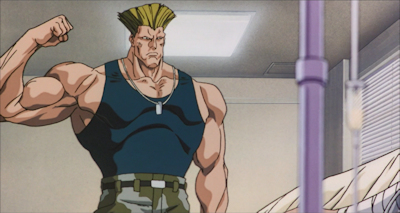

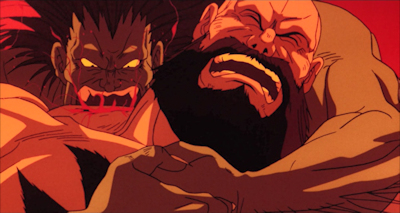
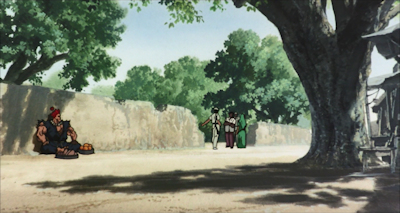
 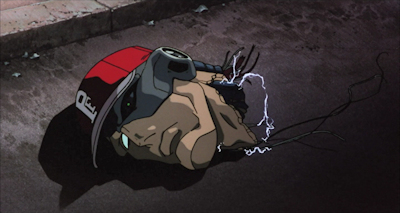

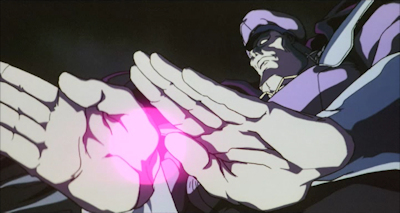
| ||||||||||||||||||||
|
| ||||||||||||||||||||
